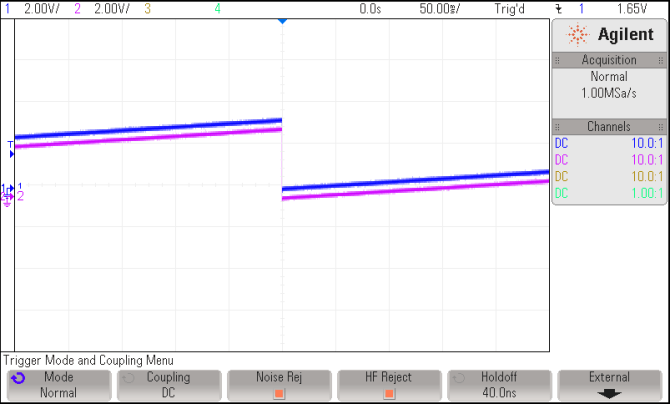SPRACM9B June 2019 – November 2020 TMS320F28384D , TMS320F28384S , TMS320F28386D , TMS320F28386S , TMS320F28388D , TMS320F28388S , TMS320F28P650DH , TMS320F28P650DK , TMS320F28P650SH , TMS320F28P650SK , TMS320F28P659DH-Q1 , TMS320F28P659DK-Q1 , TMS320F28P659SH-Q1
- Trademarks
- 1 Introduction
- 2 Benefits of the TMS320F2838x MCU for High-Bandwidth Current Loop
- 3 Current Loops in Servo Drives
- 4 Outline of the Fast Current Loop Library
- 5 Fast Current Loop Evaluation
- 6 Incremental Build Level 1
- 7 Incremental Build Level 2
- 8 Incremental Build Level 3
- 9 Incremental Build Level 4
- 10Incremental Build Level 5
- 11Incremental Build Level 6
- 12Incremental Build Level 7
- 13Incremental Build Level 8
- 14References
- 15Revision History
10 Incremental Build Level 5
This section verifies the position PI module and position loop. For this loop to work properly, the speed loop must have been completed successfully. When the motor is commanded to run, it is subjected to an initial alignment stage where the electrical angle and the position encoder angle count are set to zero. After ensuring a stable alignment, the motor starts to run.
- Open fcl_f2838x_tmdxiddk_settings_cpu1.h and select the level 5 incremental build option by setting the BUILDLEVEL to FCL_LEVEL5 (#define BUILDLEVEL FCL_LEVEL5).
- The current loop regulator can be selected to be PI controller or complex controller by setting FCL_CNTLR to PI_CNTLR or CMPLX_CNTLR.
- Select CURRENT_SENSE method to LEM_CURRENT_SENSE.
- Select POSITION_ENCODER to QEP_POS_ENCODER or T_FORMAT_ENCODER depending on the encoder coupled to motor.
- Select SAMPLING_METHOD to SINGLE_SAMPLING or DOUBLE_SAMPLING. If a T-format encoder is used, select SINGLE_SAMPLING and no more than 10 KHz PWM frequency. For more information, see Section 5.1.3.3.
- Right-click on the project name, and then click Rebuild Project. When the build is complete, click the Debug button, reset the CPU, restart, enable real-time mode, and run.
The key steps are explained as follows:
- Set enableFlag to 1 in the watch window. The isrTicker variable is incrementally increased as seen in the watch windows to confirm the interrupt is working properly.
- Add variables pi_pos, posArray, ptrMax, and posSlewRate to the Expressions window.
- Gradually increase voltage at variac to get an appropriate DC-bus voltage.
- Set runMotor to MOTOR_RUN to run the motor. The motor
must be turning to follow the commanded position (see the following note if the
motor does not turn properly).
- The motor runs through predefined motion profiles and position settings as set by the refPosGen() module. This module basically cycles the position reference through a set of values as defined in an array posArray. These values represent the number of the rotations and turns with respect to the initial alignment position. Once a certain position value as defined in the array is reached, it pauses for a while before slewing toward the next position in the array. Therefore, these array values can be referred to as parking positions. During transition from one parking position to the next, the rate of transition (or speed) is set by posSlewRate. The number of positions in posArray through which it passes before restarting from the first value is decided by ptrMax. Hence, add the variables posArray, ptrMax, and posSlewRate to the Expressions window.
- The parking positions in posArray can be changed to different values to determine if the motor turns as many rotations as set.
- The number of parking positions ptrMax can also be changed to set a rotation pattern.
- The position slew rate can be changed using posSlewRate. This rate represents the angle (in pu) per sampling instant.
- The proportional and integral gains of the speed and position PI controllers may be returned to get satisfactory responses. TI advises to first tune the speed loop and then the position loop.
- Bring the system to a safe stop by reducing the bus voltage, taking the controller out of real-time mode and reset. Now the motor stops.
Figure 10-1 shows the implementation block diagram.
 Figure 10-1 Level 5 Block Diagram Showing
Position Loop With Inner FCL
Figure 10-1 Level 5 Block Diagram Showing
Position Loop With Inner FCLIn the scope plot shown in Figure 10-2, the position reference, and position feedback are plotted. They are aligned with negligible lag, which may be attributed to software. If the Kp and Ki gains of the position loop controller are not chosen properly, this may lead to oscillations in the feedback or a lagged response.
 Figure 10-2 Scope Plot of Reference
Position to Servo and Feedback Position
Figure 10-2 Scope Plot of Reference
Position to Servo and Feedback Position- If the motor response is erratic, then the sense of turn of the motor shaft and the encoder may be opposite. Swap any two phase connections to the motor and repeat the test.
- The position control implemented here is based on an initial aligned electrical position (= 0). If the motor has multiple pole pairs, then this alignment can leave the shaft in different mechanical positions depending on the prestart mechanical position of the rotor. If the mechanical position repeatability or consistency is needed, then the QEP index pulse must be used to set a reference point. This may be taken as an exercise. With an absolute encoder, this may be obvious.